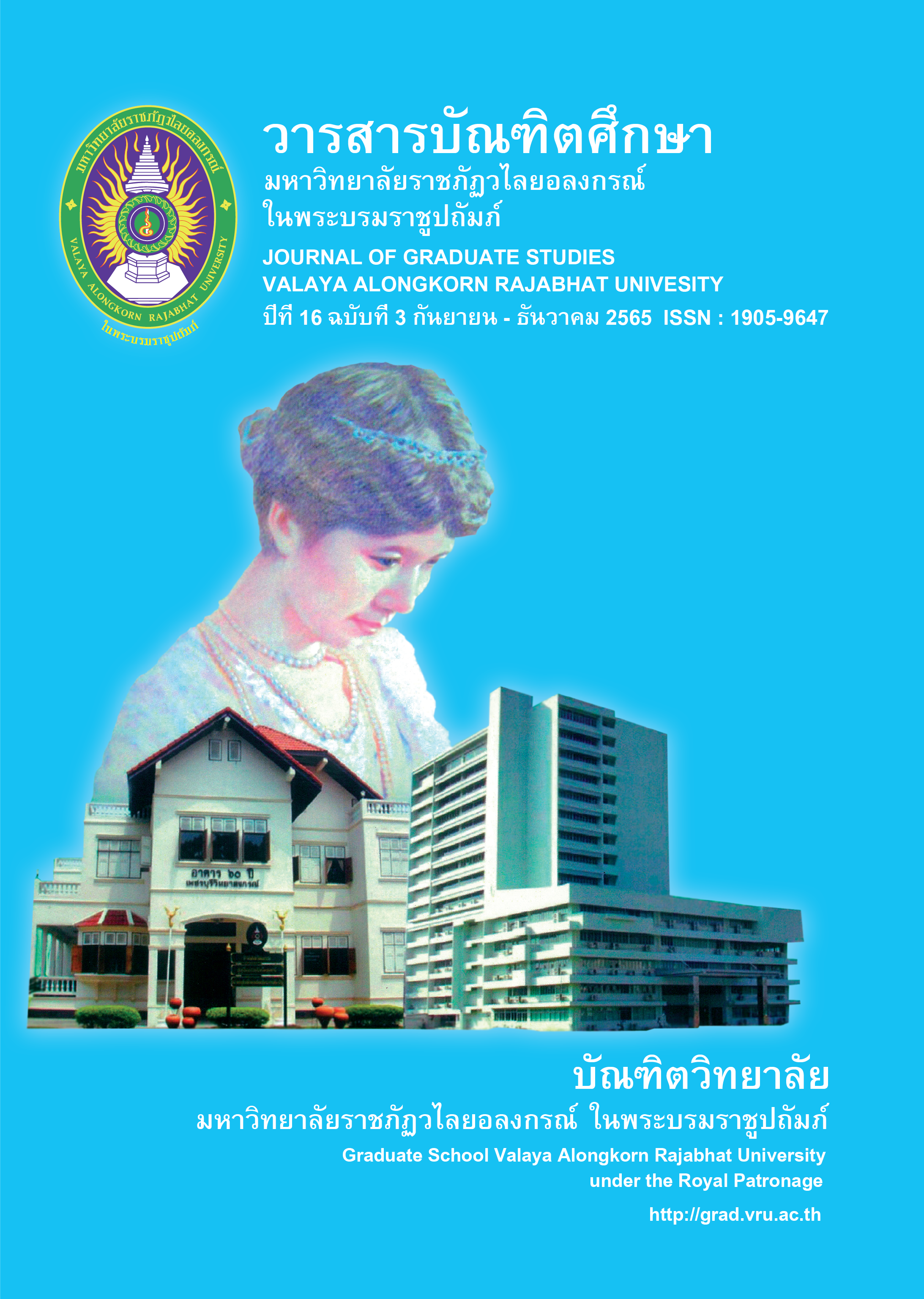FACTORS OF HUMAN RESOURCE MANAGEMENT AFFECT TO STAFF COMPETENCY NAVA NAKORN INDUSTRIAL PROMOTION ZONE PATHUM THANI PROVINCE
Main Article Content
Abstract
This research was a mixed methods research which aimed to: 1) study the level of the recruitment process, HR development process, retention process, organizational commitment and staff competency in Nava Nakorn Industrial Promotion Zone, Pathumthani Province, 2) study the influencing factors of the recruitment process, HR development process, retention process, organizational commitment in the staff competency in Nava Nakorn Industrial Promotion Zone, Pathum Thani Province, and 3) develop a human resource management model affecting the staff competency in Nava Nakorn Industrial Promotion Zone, Pathum Thani Province. In the quantitative research component, data were collected by using a 5-level rating scale questionnaire. The sample consisted of 400 executives and human resource officers of companies operating in the Nava Nakorn Industrial Promotion Zone, Pathum Thani Province during 2020-2021. The data were analyzed by means, standard deviation and structural equation model (SEM). In the qualitative research component, data were collected through in-depth interviews with 25 experts and were analyzed by the content analysis technique.
The research findings indicated that: 1) recruitment process, HR development process, retention process, organizational commitment and staff competency in Nava Nakorn Industrial Promotion Zone, Pathum Thani Province were at the high level; 2) model was in fited with the empirical data (= 145.00df = 76 p-value = .00000,
/ df = 1.90, RMSEA = .048, RMR = .0087, SRMR = .020, CFI = 1.00, GFI = .95, AGFI = .93, CN = 294.15) variables that total affect to staff competency were organizational commitment recruitment process, HR development process, retention process. And
3) the human resource management model affecting the staff competency in Nava Nakorn Industrial Promotion Zone, Pathum Thani Province had recommended that (1) the recruitment process (2) HR development and (3) the retention process.
Article Details

This work is licensed under a Creative Commons Attribution-NonCommercial-NoDerivatives 4.0 International License.
บทความทุกเรื่องได้รับการตรวจความถูกต้องทางวิชาการโดยผู้ทรงคุณวุฒิ ทรรศนะและข้อคิดเห็นในบทความ Journal of Global of Perspectives in Humanities and Social Sciences (J-GPHSS) มิใช่เป็นทรรศนะและความคิดของผู้จัดทำจึงมิใช่ความรับผิดชอบของบัณฑิตวิทยาลัย มหาวิทยาลัยราชภัฏวไลยอลงกรณ์ ในพระบรมราชูปถัมภ์ กองบรรณาธิการไม่สงวนสิทธิ์การคัดลอก แต่ให้อ้างอิงแหล่งที่มา
References
Ahammad, F. M., Glaister, W. K & Gomes, E. (2020). Strategic agility and human resource management. Human Resource Management Review. 30(1), 113 – 132.
Bin Dost, M., Ahmed, D. Z., Shafi, N., & Shaheen, W. A. (2011). Impact of employee commitment on organizational performance. Arabian Journal of Business and Management Review. 1(3), 87-98.
Dessler, G. (2009). A framework for human resource management. 5th ed. Upper Saddle River, New Jersey: Pearson Education.
Delahaye, B. L. (2005). Human Resource Development: Adult Learning and Knowledge Management. (2nded.). Australia Milton, Qld: John Wiley & Sons.
Diamantopoulos, A. & Siguaw, J. A. (2000). Introducing LISREL. London: Sage Publications.
Ekachariyakon, P. (2007). Khumattibay chang rangngan chang tumkhung. [Explanation: Hiring workers, hiring to carry out goods]. Bangkok: Winyuchon.
Fratričová, J. & Rudy, J. (2015). Get strategic human resource management really strategic: Strategic HRM in practice. International Journal of Management Cases. 17(4), 149-155.
Economic team. (2016). Crack the code “in 4.0” new economy. Crossing middle-income trap. Retrieved from http://www.thairath.co.th/content/613903.
Ivancevich, J. M. (2007). Human resource management. New York: McGraw-Hill.
Jabbour, C. J. C. & Santos, A. F. (2008). Relationships between human resource dimensions and environmental management in companies: Proposal of a model. The International Journal of Human Resource Management. 19(12), 2133-2154.
Jackson, E. S. (2012). Managing human resources for environmental sustainability. San Francisco: Jossey-Bass CA.
Konovsky, A. M & Cropanzano, R. (1991). Perceived fairness of employee drug testing as a predictor of employee attitudes and job performance. Journal of Applied Psychology. 76(5), 698-707.
Long, C. S. (2013). Transformation of HR professional to be a change agent: Realistic goal or just a dream. Journal of Advance Management Science. 1(1), 50-53.
Michael, M-C., Richard, C. & Susan, L. (2008). Human Resource Management, A case Study Approach. London: Chartered Institute of Personnel and Development.
Margaret, D. (1995). Successful recruitment and selection. London: Kogan Page Limited.
Margaret, F. & Caroline, H. (2002). Introduction Human Resource Management. Harlow: Pearson Education.
Noe, R. A. (2008). Employee training and development. New York: McGraw-Hill/Irwin.
Navanakorn Public Company Limited. (2020). Rāyngān p̄hl kār pt̩ibạti tām mātrkār d̂ān s̄ìngwædl̂xm [Report on the results of the implementation of environmental measures]. Retrieved from http://eia.onep.go.th/images/monitor/1548410315.pdf
Pholanan, T. (2003). Kār mùng nên thrạphyākr bukhkhl: Næwthāng s̄r̂āng khwām phụng phxcı kæ̀ phnạkngān [Focusing on human resources: Guide to employee satisfaction]. Bangkok: Innography.
Rothwell, W. J. (2005). Beyond training and development. New York: AMACOM,
Raymond, N. A. (2003). Human resource management: gaining a competitive advantage. New York. McGraw-Hill.
Sarkis, J., Zhu & Lai., K-H, (2010). An organizational theoretic review of green supply chain management literature. International Journal of Production Economics. 130(1), 1-15.
Salamon, M. (2000). Industrial relations: Theory and practice. (4 ed.). Edinburgh: Pearson Education.
Santiwong, T. (1992). Kār brih̄ār kh̀ā ĉāng læa ngeindeụ̄xn: Thvs̄ʹḍī læa h̄lạk pt̩ibạti keī̀yw kạb kār c̀āy kh̀ā txbthæn [Wage and Salary Management: Theory and Practice of Compensation]. 2nd edition. Bangkok: Thai Wattana Panich Printing Company Limited.
Suchitra, T. (2007). Kār phạtʹhnā thrạphyākr mnus̄ʹy̒ [Human resource development]. 2nd edition, Bangkok: Faculty of Public Administration National Institute of Development Administration.
Thienput, D. (2002). Kār brih̄ār thrạphyākr bukhkhl s̄ū̀ ṣ̄twrrs̄ʹ thī̀ 21 [Human resource management into the 21st century]. 2nd edition. Bangkok: Nagoya.
Thepawan, P. (2011). karn Borihan suppakorn cheang konlayut. [Strategic human resource management]. Bangkok: SE-Education.
Thai industrial plants. (2020). nikom autsahakham nava nakorn [Nava nakorn Industrial estate]. Retrieved from http://thailandindustry.blogspot.com/2012/07/blog- post.html
Werner, S. & Jackson, L. (2012). Human resource management. South-Western: Cengage Leaning.
Wendell, L. F. (2007). Human resource management. Boston: Houghton Miffin.
Wongsansri, P. (1995). karn Borihan suppakorn manut [Human resource management]. 5th edition. Bangkok: Faculty of Management Science Rajabhat Suan Dusit Institute.


